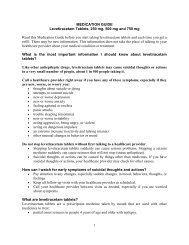Form 6-K - Dr. Reddy's
Form 6-K - Dr. Reddy's
Form 6-K - Dr. Reddy's
Create successful ePaper yourself
Turn your PDF publications into a flip-book with our unique Google optimized e-Paper software.
DR. REDDY’S LABORATORIES LIMITED AND SUBSIDIARIES<br />
UNAUDITED CONDENSED CONSOLIDATED INTERIM FINANCIAL STATEMENTS<br />
(in thousands, except share and per share data)<br />
3. Significant accounting policies (continued)<br />
f. Leases (continued)<br />
g. Inventories<br />
subsequent to initial recognition, the asset is accounted for in accordance with the accounting policy applicable to that asset.<br />
Minimum lease payments made under finance leases are apportioned between the finance expense and the reduction of the<br />
outstanding liability. The finance expense is allocated to each period during the lease term so as to produce a constant periodic rate of<br />
interest on the remaining balance of the liability.<br />
Operating leases<br />
Other leases are operating leases and the leased assets are not recognized on the Company’s balance sheet. Payments made under<br />
operating leases are recognized in profit or loss on a straight-line basis over the term of the lease.<br />
h. Impairment<br />
Inventories consist of raw materials, stores and spares, work in progress and finished goods and are measured at the lower of cost and<br />
net realizable value. The cost of all categories of inventories, except stores and spares, is based on the first-in first-out principle.<br />
Stores and spares is comprised of packing materials, engineering spares (such as machinery spare parts) and consumables (such as<br />
lubricants, cotton waste and oils), which are used in operating machines or consumed as indirect materials in the manufacturing<br />
process, where cost is based on a weighted average method. Cost includes expenditures incurred in acquiring the inventories,<br />
production or conversion costs and other costs incurred in bringing them to their existing location and condition. In the case of<br />
finished goods and work in progress, cost includes an appropriate share of overheads based on normal operating capacity. Net<br />
realizable value is the estimated selling price in the ordinary course of business, less the estimated costs of completion and selling<br />
expenses.<br />
Financial assets<br />
A financial asset is assessed at each reporting date to determine whether there is any objective evidence that it is impaired. A<br />
financial asset is considered to be impaired if objective evidence indicates that one or more events have had a negative effect on the<br />
estimated future cash flows of that asset.<br />
An impairment loss in respect of a financial asset measured at amortized cost is calculated as the difference between its carrying<br />
amount, and the present value of the estimated future cash flows discounted at the original effective interest rate. An impairment loss<br />
in respect of an available-for-sale financial asset is calculated by reference to its fair value.<br />
Individually significant financial assets are tested for impairment on an individual basis. The remaining financial assets are assessed<br />
collectively in groups that share similar credit risk characteristics.<br />
All impairment losses are recognized in profit or loss. Any cumulative loss in respect of an available-for-sale financial asset<br />
recognized previously in equity is transferred to profit or loss. An impairment loss is reversed if the reversal can be related<br />
objectively to an event occurring after the impairment loss was recognized. For financial assets measured at amortized cost and<br />
available-for-sale financial assets that are debt securities, the reversal is recognized in profit or loss. For available-for-sale financial<br />
assets that are equity securities, the reversal is recognized directly in equity.<br />
Non-financial assets<br />
The carrying amounts of the Company’s non-financial assets, other than inventories and deferred tax assets are reviewed at each<br />
reporting date to determine whether there is any indication of impairment. If any such indication exists, then the asset’s recoverable<br />
amount is estimated. For goodwill and intangible assets that have indefinite lives or that are not yet available for use, the recoverable<br />
amount is estimated each year at the same time.<br />
The recoverable amount of an asset or cash-generating unit is the greater of its value in use and its fair value less costs to sell. In<br />
assessing value in use, the estimated future cash flows are discounted to their present value using a pre-tax discount rate that reflects<br />
current market assessments of the time value of money and the risks specific to the<br />
16




